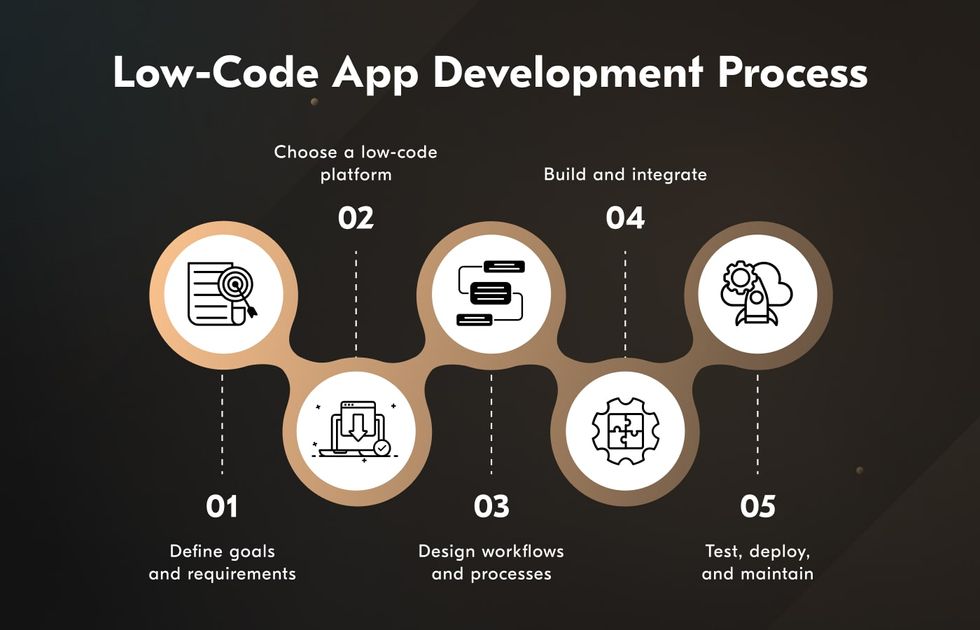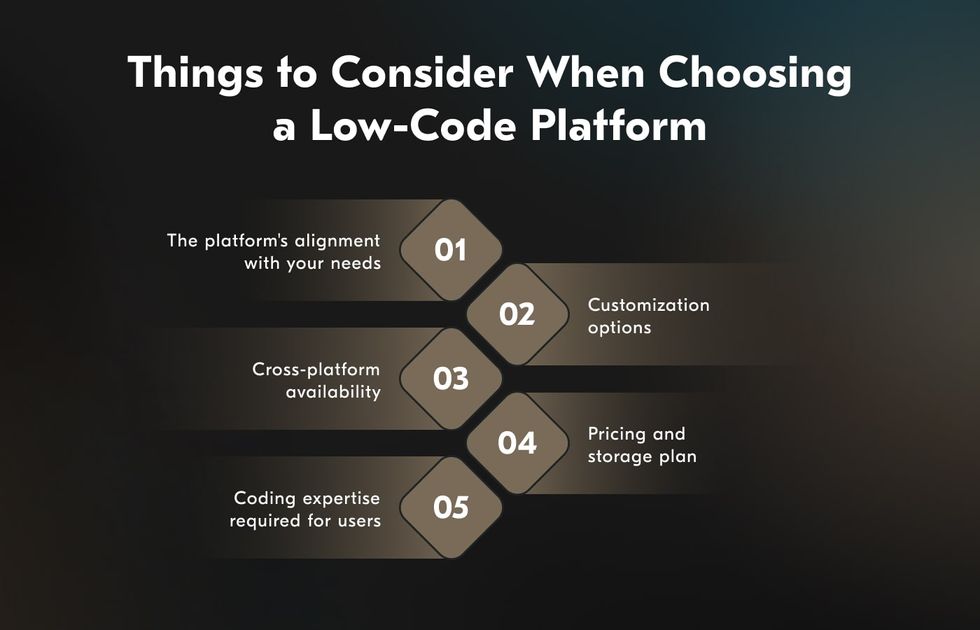
Key Takeaways
- Low-code development is rapidly gaining traction, with 60% of software development organizations expected to use it as their primary platform by 2025.
- It simplifies software creation through visual interfaces and pre-built components, enabling both developers and non-developers to build apps faster and more efficiently.
- These platforms integrate seamlessly with existing systems and allow apps to adapt to changing business requirements without extensive rework.
- The low-code market, valued at $31.9 billion in 2024, is set to reach $274 billion by 2033, growing at a 27% CAGR.
- Startups and enterprises benefit from faster time-to-market, making low-code ideal for MVPs and automated workflows.
Low-code is an intuitive visual alternative to coding that’s taken the market by storm. Gartner projects that 60% of software development organizations will rely on enterprise low code platforms as their primary internal developer platform, up from just 10% this year.
If you’re on the brink of diving into the low-code world but still have some reservations, this article is for you. Acropolium has been working with low-code long enough to learn all about the benefits and technicalities of low-code application development.
For any business from logistics and healthcare to hospitality, it’s an essential tool in our arsenal, and we’re excited to share our experience with you. Today, we will break down the development process and low-code limitations.
What is low code development and why is it important?

Low-code app development simplifies the process of creating software by using visual interfaces and pre-built components, enabling both developers and non-developers to build applications quickly.
Basically, a low-code development platform is a collection of modular components and the tools needed to assemble them into fully functional applications. Using a platform, citizen developers can easily design user interfaces, test and deploy apps, and integrate them with other software.
Even seasoned pros can utilize pre-built blocks to speed up development, adding code to cater to more specific client needs. This approach has become essential in addressing enterprise needs, with low-code tools handling over 65% of application development.
In fact, 60% of custom enterprise apps are now built by non-developers, with 30% created by employees with little to no technical skills.
The market, valued at $31.9 billion in 2024, is projected to grow to $274 billion by 2033, at a 27% CAGR. For example, HR teams can create custom onboarding portals, and marketing departments can build campaign trackers without extensive coding.
Low-code platforms and their role in mobile app development

In the low-code paradigm, mobile apps are created from pre-built modules. People can just work in a visual environment using drag-and-drop controls and choose from a pool of settings and components covering typical functionality. Adding code may be necessary at times, but many business tools can be built without programming experience whatsoever.
Due to the growing popularity of low-code platforms, there are plenty of options on the market. Platforms may differ significantly in terms of the offered modules, controls, and specialization, but they share the same core functionality.
So what are those basic ingredients that make low-code platforms a great choice for mobile app development?
Benefits of low-code application development

Building an application is like assembling a house from pre-made blocks — fast, efficient, and cost-effective. But if you think saving time and money are the only perks you get from using low-code, you don’t see the whole picture. Over the years of delivering low-code solutions, we’ve compiled a more extensive list.
Cost efficiency and accessibility
Low-code application development dramatically lowers development expenses by reducing the need for large teams of specialized developers. The modular, drag-and-drop approach saves time and resources, allowing businesses to focus on strategic priorities. This direct involvement minimizes communication gaps and accelerates delivery.
Unless you need a sophisticated custom solution, designing an app with low-code can help you digitize your workflow in no time.
Reduced development costs
A software developer in the US earns an average of $4,700 per month. Multiply this by the number of specialists you’d need for the project—and that’s the amount you’ll be able to save or invest into more critical aspects of your business.
Flexibility and scalability
Low-code seamlessly integrates with existing systems, making it a win-win for businesses looking to extend or improve legacy software. With reusable components, low-code apps grow with your business, offering scalability and adapting to new challenges and requirements without extensive rework.
Unlike hand-coded software, apps built with low-code can be easily updated with new features. And you won’t even have to hire remote professional developers for the job.
Instant testing and faster time to market
Beyond these foundational benefits, low-code platforms shine in specific scenarios. Startups can test MVPs swiftly, significantly improving time-to-market. Established businesses leverage them to automate processes like data analytics, CRM, and ERP with pre-built modules, saving months of development time.
In a recent survey by Statista, the majority of respondents reported a significant increase in the development speed — from 21% to 80%.
Reliable performance out of the box
Since low-code mobile app development platforms are thoroughly tested before release, you don’t have to worry about performance issues or other quirks. On top of that, they’re often based on modern tech like cloud computing and artificial intelligence.
Сore features of low-code mobile app development platforms

As we mentioned earlier, low-code app development solutions can be composed of a variety of modules. Those pre-designed blocks can help you streamline multiple business processes like sales and marketing, finance, human resources, customer service, business intelligence, and so on.
To understand how the magic works better, we need to look at low-code platforms at the macro level. Here are the essential tools and principles that lie at the heart of low-code development:
- Drag-and-drop interfaces. The hallmark of low-code web applications, drag-and-drop controls make app creation intuitive and efficient. Both professional developers and citizen developers can visually design interfaces and features without writing extensive code.
- Reusable components and templates. Low-code platforms enable developers to reuse components like forms, workflows, and UI elements across different projects, saving time and lowering the risk of project failure. These pre-built templates further simplify app development.
- Pre-built connectors for integrations. Modern low-code platforms often include pre-built connectors to integrate seamlessly with third-party apps, SaaS solutions, or on-premises systems using APIs. This simplifies data flow and connectivity across tools.
- Security and compliance features. Security is a top priority for any application, and low-code platforms include built-in tools for encryption, user authentication, and compliance with regulations like GDPR and HIPAA. This ensures that apps meet enterprise-grade standards.
- Real-time collaboration tools. Low-code platforms excel at enabling teamwork, allowing multiple users to collaborate on projects simultaneously. Real-time feedback and editing help teams stay aligned and productive.
- Visual modeling. The ability to work in a visual IDE (integrated development environment) is what both professional and citizen (non-technical) developers love about low-code. Designing user interfaces and building features is quick and intuitive with drag-and-drop controls.
- OOTB functionality. The whole point of using ready-made modules is that they shouldn’t require any extra coding in order to work. This is exactly the case with mobile low-code solutions — their components are ready for action the minute you deploy them.
- Cross-platform availability. Another reason why low-code app developers enjoy working with this approach. No need to build separate apps for mobile and desktop — the low-code suite will compile the necessary versions automatically.
- Data analytics and reporting. The support of data analysis is essential for most of today’s commercial apps. Low-code platforms offer such tools, so you can efficiently monitor key metrics and capitalize on the insights you gain.
- Application life cycle management tools. Every application needs to be tested prior to and maintained after deployment. The process of updating your app should also be streamlined. With most platforms, you’ll find this functionality included in the standard package.
As you can see, low-сode development tools are rich in features and can cover very complex needs. But the benefits don’t end there.
Limitations of low-code: When to avoid using it

Low-code isn’t a one-size-fits-all solution. In a number of scenarios and use cases, things need to be done the classic way. We advise against using low-code if you find yourself in one of the following situations.
Complex business logic and functionality
While the idea behind low-code is that pre-built modules should cover typical business needs, no single platform can handle every possible combination. Some are optimized for creating prototypes and improving team collaboration, while others are great at integrating with other software and data sources.
If you plan to create a feature-rich app with intricate logic or IoT models like GPS, the low-code app development approach might not be your best choice. Traditional methods of building software or a hybrid solution, on the other hand, should give you the right degree of flexibility.
Limited options for highly specialized features
Certain business needs require features that go beyond the standard modules provided by low-code platforms. These tools are typically optimized for common use cases, leaving little room for custom, unconventional requirements.
Customization constraints for complex apps
Low-code platforms excel at rapid prototyping and general-purpose app creation, but their customization capabilities are limited. Visual tweaks like colors and fonts are easy to adjust, but achieving a unique look or implementing niche features can be challenging. Companies with specific branding or functionality needs may find these constraints restrictive, requiring additional hand coding.
High security requirements
Some industries, such as finance and healthcare, set higher requirements than others when it comes to data security. Businesses that operate with massive amounts of personal, medical, or financial information just can’t afford security breaches or data leaks. The issue of regulatory compliance can’t be ignored, either.
Although low-code platforms uphold certain security standards, they may be insufficient or not specific enough for some projects. And since you can’t access or alter the source code, there’s no way of fixing this problem from the inside.
Luckily, experienced developers know which code tools to use to mitigate low-code security risks. Building a custom solution with a software outsourcing partner is a surefire way to address your security concerns.
Risk of vendor lock-in
Sooner or later, you might find that you’ve exceeded the capabilities of your current platform and need to find an alternative. But vendors create their low-code platforms for a competitive market, so most of them aren’t compatible with each other. Moreover, some platforms only support their proprietary languages (like Zoho’s Deluge, for instance). This can seriously restrict your options when searching for developers and incur higher costs.
However, the problem is that you can’t always see a platform’s limitations until you run into them. And when you do, with rare exceptions, switching to another platform will mean doing the same work all over again. Take these factors into account before committing to a low-code platform.
The solution? More hand coding.
Before deciding to opt for low-code, you have to carefully assess the potential risks and choose the right platform that will suit your business needs. Otherwise, you may end up spending more resources on fine-tuning the app than you would have on building it from scratch.
Of course, we’re not trying to discourage you from using low-сode development tools. Especially since building applications with the use of low-code platforms is straightforward and fun.
The process of low-code app development

Developing apps with low-code follows a similar logic to traditional coding but streamlines the process, cutting steps and bureaucracy. Here’s how it works:
Define goals and requirements
Start by clarifying why you need the app and what it should achieve. Align your team on features, data types, user needs, and expected performance to set clear expectations.
Choose a low-code platform
Selecting the right platform is critical, as switching later can be costly and complex. Consider your business needs carefully before committing. Once chosen, you can begin building.
Design workflows and processes
Use the platform’s visual tools to map out workflows and app logic by dragging and dropping elements. Define variables, configure UI blocks, and visualize the interface and internal processes as diagrams. Collaboration tools allow business users and developers to exchange ideas and prototype in real time, reaching consensus quickly.
Build and integrate
Leverage pre-built apps or external integrations through APIs. Customize UI and features, relying on the platform to handle backend functions. If needed, professional developers can add custom code.
Test, deploy, and maintain
Low-code/no-code application development simplifies testing and deployment, with automated tools minimizing manual effort. Standard maintenance is often built into the platform package, leaving little for your team to manage.
With your app ready, you can focus on enjoying its benefits — or revisit the process of choosing the ideal platform, which is worth exploring further.
Some advice on choosing the right low-code platform

Choosing the right low-code platform means aligning it with your project’s priorities. Not all platforms are universal; they differ in focus, capabilities, and coding requirements. For instance, Appian excels in creating enterprise apps for business and data management, empowering non-technical users to build applications with ease. In contrast, App Builder by Infragistics is better suited for complex domains like e-commerce or fintech, requiring more advanced coding knowledge to unlock its full potential.
To select wisely, consider these key factors:
- Does the platform align with your use case and business domain?
- Are sample projects visually appealing and customizable enough?
- Can it handle desktop, web, and mobile development, including automatic iOS and Android app generation?
- Are pricing and storage limitations clear? What happens if you exceed your plan?
- What coding expertise does the platform demand?
For an unbiased evaluation, consulting a software partner can also help ensure the platform meets your needs.
Going low-code with Acropolium
Even though we love coding more than anything, we also enjoy the low-code approach. It can be such a universal yet precise tool when used with purpose. We mostly mix it with manual code, combining the best of both worlds when our clients have tight deadlines and complex needs.
Our low-code app developers have learned to recognize the use cases where this approach shines, leaving other approaches far behind.
Some of the low-code projects we’ve worked on include:
- A restaurant chatbot, where the client reduced development costs by 75%, speeding up the time to market by 60%.
- A wellness social media app for which we developed an MVP in just three months, allowing the client to test their product right away before the launch.
- An addiction recovery app with a 100% elimination of maintenance costs and a 36% increase in new patient rate.
The bottom line
Low-code application development has found its niche in the market, and its popularity will continue to grow. A great choice for young enterprises, this method is equally applicable for established companies that want to speed up their digital transformation and automate business processes.
The trick is to objectively assess one’s needs and balance the featherweight agility of low-code with the heavyweight arsenal of traditional coding. Acropolium has been doing this for 20+ years, and we’ve become quite good at it.
Let’s get in touch, and we’ll help you find that equilibrium.









![15+ Low-Code Use Cases [Real-World Examples Included]](/img/articles/low-code-use-cases/img01.jpg)

![ᐉ Low-Code MVP Development: [Pros, Cons, Guide]](/img/articles/low-code-mvp/img01.jpg)
![Low-Code in Healthcare [5 Use Cases]](/img/articles/low-code-healthcare/img01.jpg)

